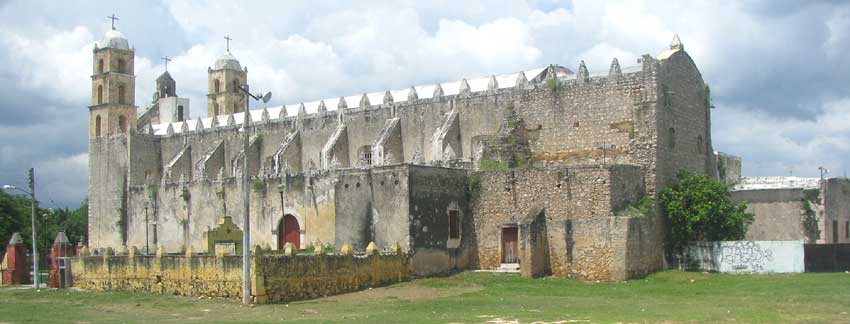Excerpts from Jim Conrad's
Naturalist Newsletter

from the September 19, 2010 Newsletter issued from Hacienda Chichen Resort beside Chichén Itzá Ruins, central Yucatán, MÉXICO; limestone bedrock, elevation ~39m (~128ft), ~N20.676°, ~W88.569°
HOCTÚN'S CHURCH
Last Monday my long-enduring visa saga took me to Mérida again so once more I found myself on a rumbling Oriente bus heading west, stopping at all the little towns along the way, Holca, Kantunil, Xocchel... nice little places, so much color, so many random juxtapositions of incongruous elements, lush vegetation, scroungy dogs and smiling faces.
Several towns along the route are home to colonial churches that seem far too large for such small places. I've been told that usually such big churches mark centers which once served to "concentrate" the Maya, so the clergy and Spanish-blooded landlords could easier control them.
Hoctún, with about 4700 inhabitants, of which a third are children, has one of the largest churches. You can see it in a picture taken through the bus window above.
The earliest mention I can find of something happening specifically to the people of Hoctún was dated 1722, when the lady Doña Angela de la Fleguera Castillo was granted, under conditions of the Encomienda System, 269 Maya citizens of Hoctún.
With such a big church I thought that maybe Hoctún had served as an especially important concentration center, but I couldn't find reference to such an event, if it existed. However, in Terry Rugeley's 1996 book Yucatán's Maya Peasantry and the Origins of the Caste War, with most pages online via Google Books, there's a revealing story about an event in Hoctún in 1829, eight years after both Mexico gained independence from Spain, and the independent entity of Yucatán joined the Mexican Republic.
In 1829 the Yucatán had been divided into parishes. The home office of Hoctún Parish surely was the church in the picture. That year some Maya farmers needed new pastureland so they sent out scouts, who found good land in adjacent Cacalchén Parish. Wanting to proceed legally, they applied to Cacalchén's authorities for permission to relocate there, and permission was granted. Since in those days the Maya were obliged to work for the creole population -- creoles in this case being people born in Mexico but mostly of Spanish blood -- the Maya who moved onto the new land transferred their "fagina" (or fajina, pronounced fa- HEE-na) obligations to their new parish. The Church-sanctioned fagina was a set of obligations each Maya worker was forced to fulfill for their creole overlords.
When Raymundo Pérez, priest of Hoctún, got wind of the situation, he wrote to the bishop asking that the peasants be restored to his own jurisdiction and his own tax rolls. The Church sided with Pérez, who'd argued that if Maya peasants could go where they wanted it would constitute a fundamental threat to Church/creole authority and the tax base. Pérez's argument had been based solely on issues of power and money, with no reference to the welfare of the Maya.